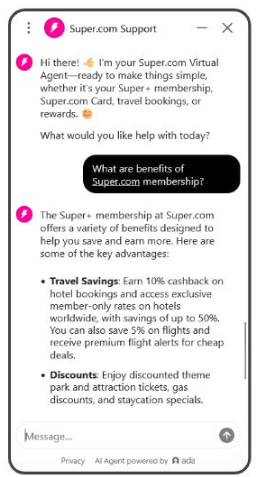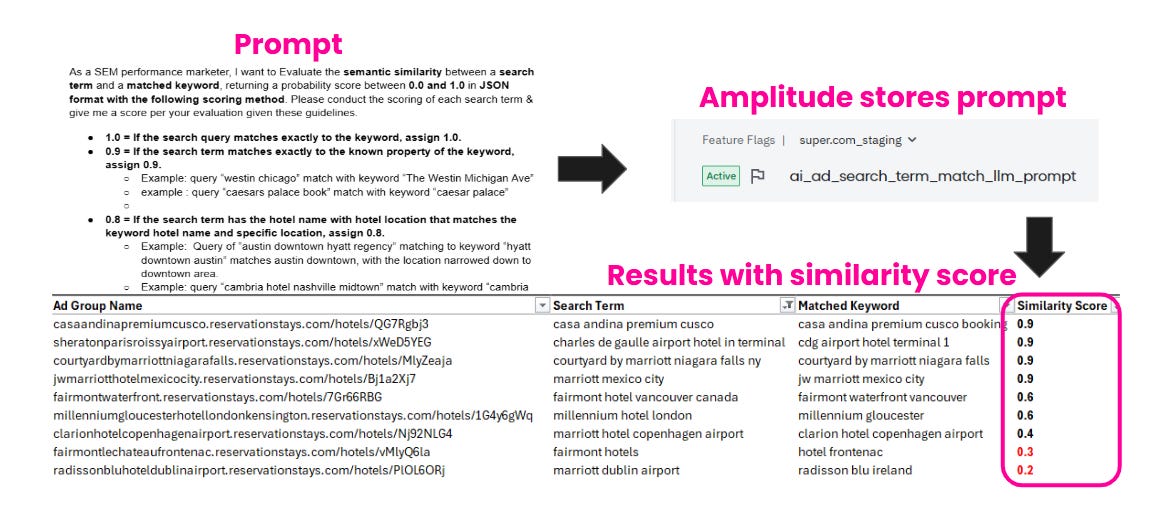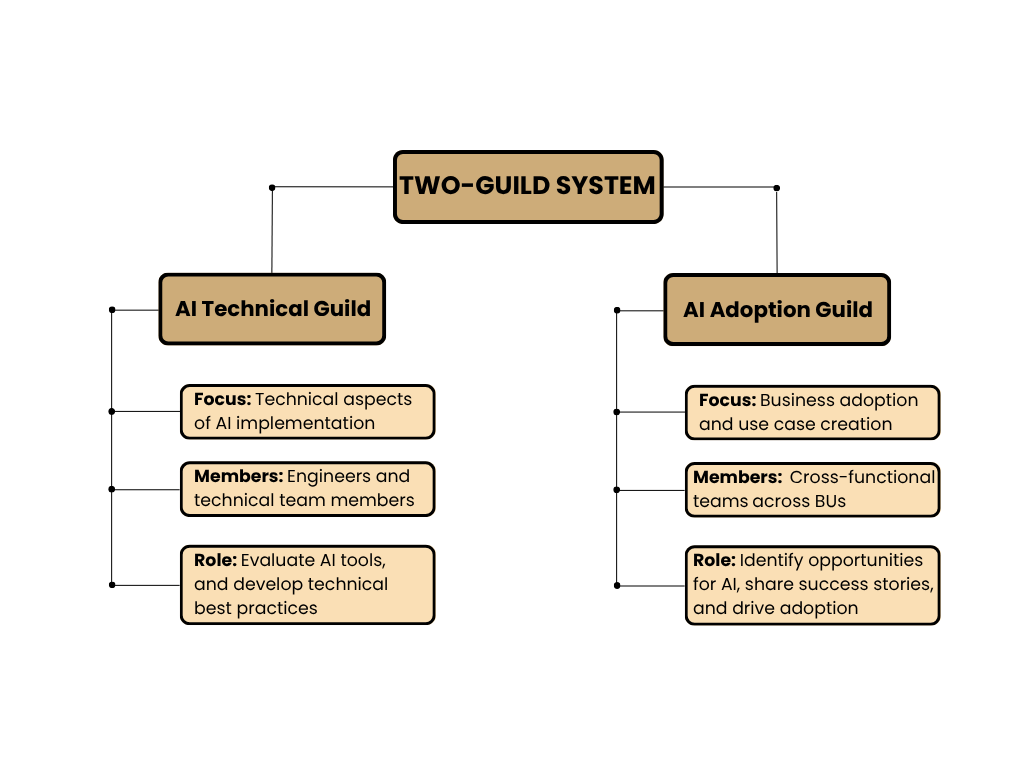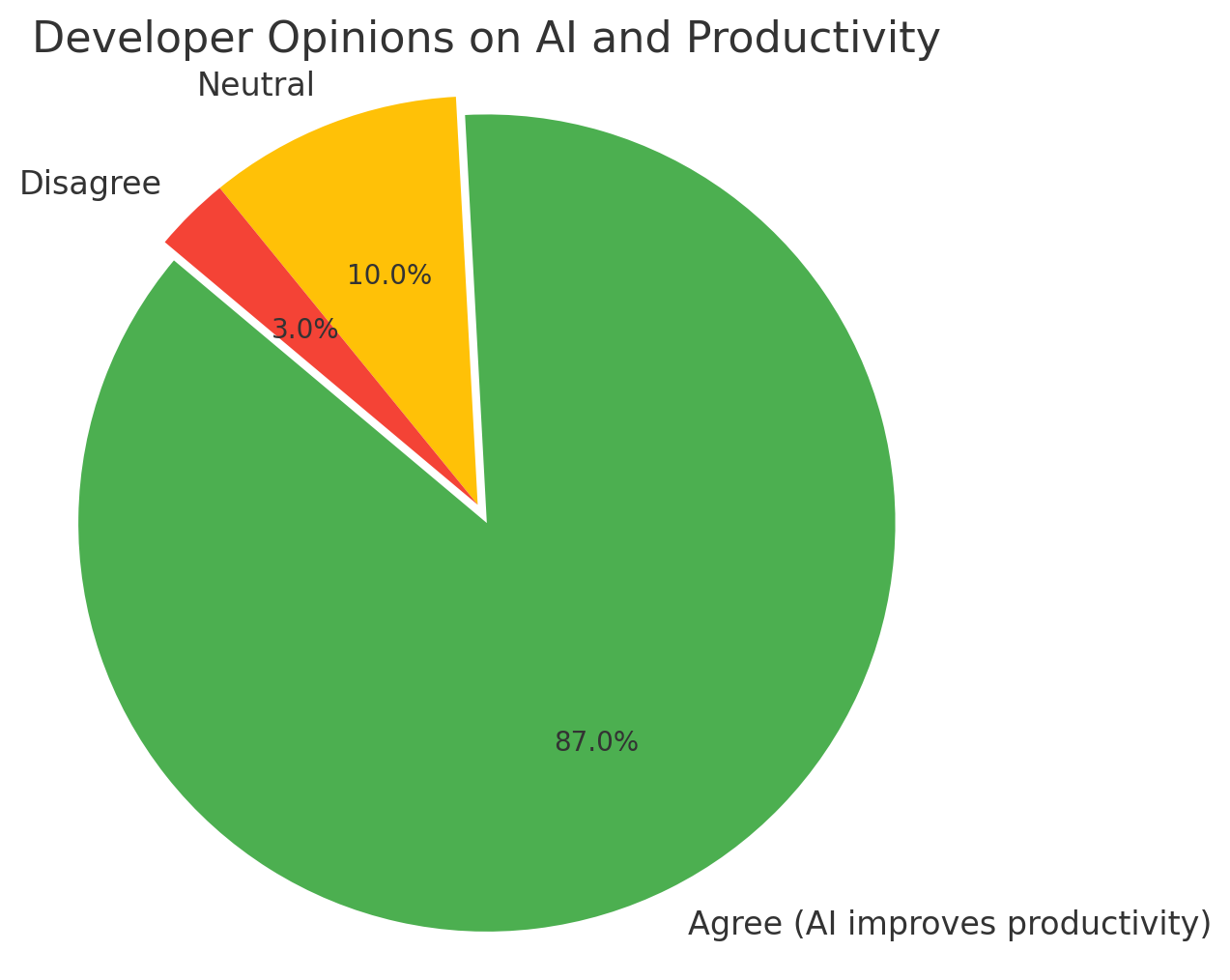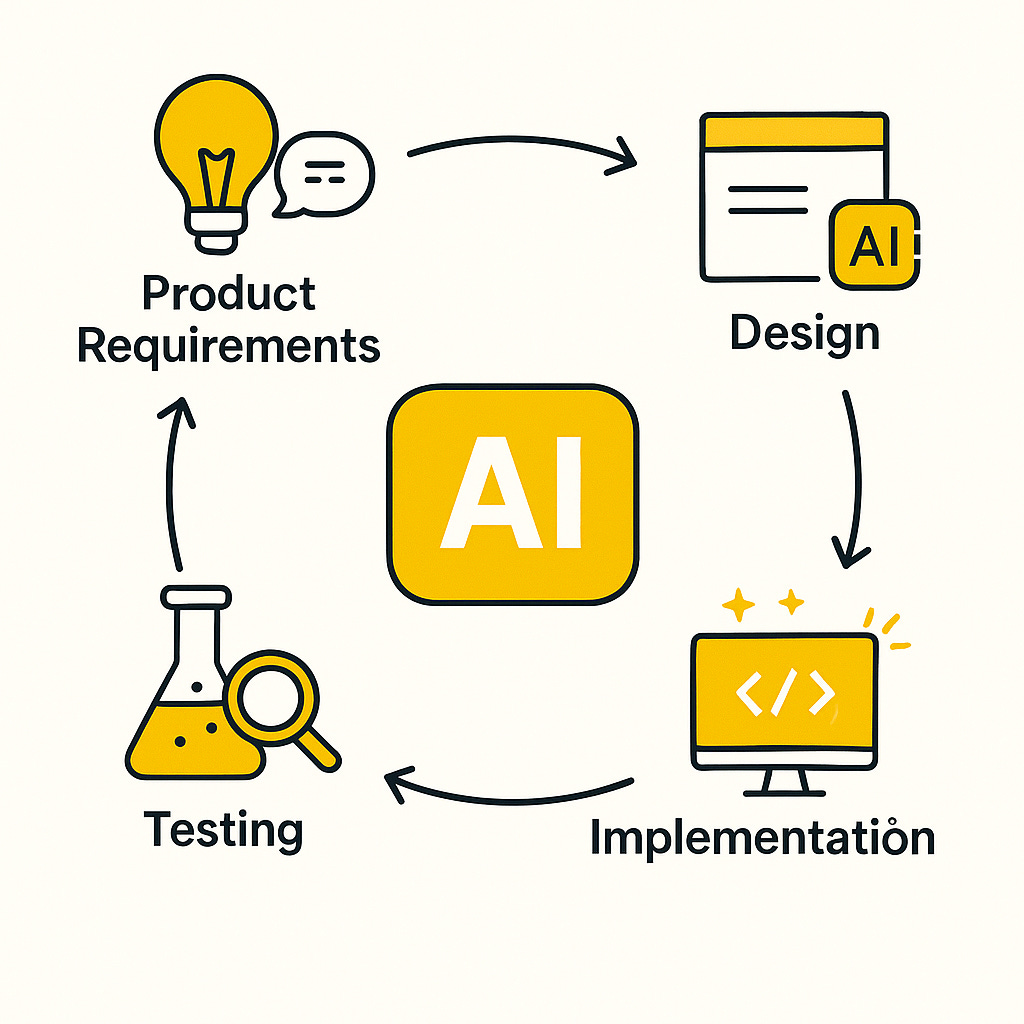Lean AI at Scale: The Official Playbook for Scale-Ups and Growth Stage Companies
Based on proven strategies from Super.com's AI transformation to $200M+ annualized revenue
Table of Contents
The Three-Pillar Framework
Product Integration Strategies
Building Internal AI Capabilities
Productivity 2.0 Implementation
Measurement and Results
Future Strategic Initiatives (Super.com’s next AI bets)
Key Lessons and Best Practices
A little back story….
Most AI success stories are marketing fluff. Generic case studies and surface-level insights that tell you what happened, but never how it actually worked.
This playbook is different.
For the first time, we are pulling back the curtain on a real AI transformation at scale.
For some background, I am a co-founder (now a board member) at Super.com.
This gives me unprecedented access to share what no outsider has ever seen: the complete, unfiltered playbook of how a $200M+ annualized revenue company achieved ~$1 million revenue per employee through systematic AI adoption.
Super.com has become the first scale-up to join the Lean AI Leaderboard and demonstrate what truly lean AI operations look like at this scale.
Since then, I have received countless messages from scale-ups and growth-stage founders asking for our playbook.
So, I am sharing our operational playbook (the one we use internally to guide our AI transformation) with complete transparency, no gatekeeping.
I'm giving you the exact roadmap we used, and everything you are about to read comes from our boardroom discussions and team implementations.
Shout-out to our CEO, Hussein, and our CTO, Ryan, for helping me bring this playbook to my readers.
Our Model: Proven Results at Scale
Super.com wasn't built as an AI company.
We started 9 years ago in the pre-AI era, grinding through the traditional playbook of hiring more people to solve more problems (although we started as a chatbot and won an IEEE award).
Like most companies, we scaled by adding headcount instead of getting more done with the resources we had
Then everything changed as we adopted AI.
Our transformation shows how growth-stage companies and scale-ups can systematically implement these principles to drive measurable business results.
With $200M+ annualized revenue and just over 200 employees, we have achieved remarkable outcomes through our structured approach to AI adoption.
This playbook distills our systematic approach into actionable strategies for similar organizations, providing a proven path from AI principles to measurable business transformation.
Our Three-Pillar Framework
We organize our AI strategy into three mutually reinforcing pillars:
Pillar 1: Product Integrations
Goal: Leverage AI in products to drive business and customer value
Our Implementations:
40% of customer support chat contacts resolved by AI
Millions of incremental revenue using AI-optimized pricing
Hundreds of thousands saved annually on SEM keyword optimization
Low-code AI personalization - no two users will see the same app
Triaging and resolving customer-reported issues
AI-driven inventory consolidation, showing a 100% improvement in early testing
Pillar 2: Internal Expertise, Capabilities, Guidelines
Goal: Build company AI familiarity to leverage AI across use cases (technical and non-technical)
Our Structure:
Two AI guilds: Technical Guild and Adoption Guild
AI Lead role for internal strategy ownership
Internal AI Platform to make it simple to experiment with new AI integrations
Published internal AI policy and guidelines
Pillar 3: Productivity 2.0
Goal: Expand AI for internal productivity and cost efficiency
Our Results:
93.5% of developers use AI tools; 86% use Cursor
25% of Cursor sessions are non-engineers (codebase Q&A, writing scripts, small PR fixes)
Built an internal MCP server to get more done within Cursor
AI code reviews, unit test generation, end-to-end test generation, and security analysis
Recruitment and deep research automation
Product development lifecycle AI agents (status updates, PRDs, story pointing)
Automating internal Ops workflows, saving many hours per week
Product Integration Strategies
Customer Support Automation
Our Implementation with Ada:
Previous Platform: Gladly Sidekick
Current Platform: Ada for leading AI self-serve customer support
Results: 49.8% relative decrease in customers who speak to an agent
Current Performance: 40% of customer chat contacts are now resolved by AI
Efficiency Gain: Resolution time decreases by 90% when resolved by AI vs. human
Cost savings: $100,000+ in cost savings from reduced agent volume
Implementation Strategy:
Platform Migration
Evaluate AI-native customer support platforms
Focus on self-serve capabilities
Ensure integration with existing workflows
Gradual Rollout
Start with common query types
Monitor resolution rates and customer satisfaction
Expand to more complex workflows over time
Future Expansion Plans:
Shifting phone support to chat
More complex automated workflows
Personalized AI responses
Integration with Loris.AI for agent quality monitoring
SEM Cost Optimization
Our Results:
Annual Savings: $290K from keyword optimization (anticipated savings of $500K by 2026)
Methodology: AI-driven keyword pruning to eliminate low-performing spend
Scope: Excluded 4.35% of search terms, representing 1.2% of total spend
Implementation Time: Approximately 1 quarter with 1 engineer to achieve full savings
Technical Implementation:
AI Model: ChatGPT-4o LLM via OpenRouter API
Integration Platform: Superblocks for low-code UI
Process: Automated semantic similarity analysis between search terms and matched keywords
System Architecture:
Prompt Management: Amplitude stores prompts for consistent analysis and enables A/B testing
Similarity Scoring: AI evaluates the semantic similarity between search terms and keywords
Results Processing: System returns similarity scores for optimization decisions, and a DAG actions accordingly
Revenue Optimization through Multi-Armed Bandits
Our Pricing Strategy:
Approach: Reinforcement learning style pricing strategy with feedback loops
Key Insight: There are different optimal take rates depending on itinerary context, so we used different feedback loops per “context”
Testing Method: Fluctuating take rate based on user behavior and context
Results: Reward metric (proxy for Revenue Per Search) increased by >50%, corresponding to millions in incremental revenue
Personalization with Predictive Cohorts
Our Amplitude Integration:
Platform: Amplitude Predictive Cohorts for low-code personalization
Use Case: Predicting the likelihood of users earning rewards to become Super+ members
Data Source: Leverages existing analytics data sent to Amplitude
Conversion Results by Predicted Likelihood:
Planned Applications:
Craft optimal experiences for each user based on app behavior
Customize what users see, notifications sent, and app layout
Experiments for homepage component ordering
Future Vision: No two users will see the same app - AI personalizes layouts, offerings, and notifications for each individual to maximize customer and business value.
Building Internal AI Capabilities
AI Guilds Structure
Our Two-Guild System:
AI Technical Guild:
Focus: Technical aspects of AI implementation
Members: Engineers and technical team members
Responsibilities: Evaluate AI tools, develop technical best practices, and support complex integrations
AI Adoption Guild:
Focus: Business adoption and use case development
Members: Cross-functional representation from all departments
Responsibilities: Identify AI opportunities, share success stories, and drive adoption
Meeting Structure: Monthly meetings with company-wide representation to build AI integration expertise and capabilities across both technical and non-technical team members.
Internal AI Platform
Our Implementation:
Purpose: Low-code LLM integrations and prompt refinement via A/B testing
Current Applications: SEM keyword optimization and inventory consolidation projects
Architecture: Centralized service for consistent AI implementation across departments
Service Capabilities:
Prompt management and optimization
Integration with business tools and workflows
Standardized AI model access and usage
Cost tracking and performance monitoring
AI Lead Role
Our Hiring Strategy:
Responsibilities: AI integration expert for the organization
Sample Projects: AI Inventory Consolidation, AI Fraud Detection
Focus: Strategic AI implementation across departments
Role Requirements:
AI integration expertise
Cross-functional leadership capabilities
Technical background with business acumen
Experience scaling AI/ML in enterprise environments
AI Guidelines and Governance
Our Policy Framework:
Published Policy: Internal guidelines covering AI Assistants and responsible AI usage
Scope: AI Assistants, Coding Copilots, Product Integrations, and Notetakers
Focus: Responsible, transparent, and secure AI usage across the organization
Policy Areas:
Approved Use Cases: Clear guidelines on where and how AI can be used
Quality Standards: Requirements for accuracy, human oversight, and performance monitoring
Security Guidelines: Data protection and privacy considerations
Compliance Requirements: Regulatory and legal considerations for AI usage
Productivity 2.0 Implementation
Developer Productivity
Our Developer AI Adoption:
Overall Adoption: 93.5% of developers using AI tools
Primary Tool: 86% of AI-using developers use Cursor
Productivity Impact: Based on developer survey, 86.7% agree AI improves productivity, 10% neutral, 3% disagree
Output Metrics: 50% year-over-year increase in lines of code with approximately same headcount
Implementation Areas:
Core Development: Feature implementation, codebase refactors (e.g., TypeScript migration)
Code Quality: Asking questions about the codebase, writing one-time scripts, and debugging errors
Advanced Features: AI Unit Testing, AI Code Reviews, and AI E2E testing
Telemetry and Measurement:
Built out IDE telemetry to observe how developers use AI tools
Process of tying usage to metrics like lines of code (LOC) and cycle time
Regular surveys to track productivity improvements and satisfaction
Non-Engineering AI Adoption
Our Cross-Functional Usage:
Adoption Rate: 25% of Cursor sessions are from non-engineers
Teams Using AI: Data analytics, product design, operations, corporate support, QA
Primary Use Cases: Codebase Q&A, small code fixes, writing one-time scripts
Onboarding Success: Non-SWE can onboard to Cursor with access to our remote execution environments in under 10 minutes
Specific Applications by Role:
Product Managers: Codebase exploration, understanding system architecture
Designers: Small UI fixes, component adjustments
Operations: Data scripts, process automation
QA: Bug fixes, test script creation
Support: Technical issue debugging
Engineering Sessions:
Non-Engineering Sessions:
Non-Engineering Sessions By Department
Advanced Security and Quality Assurance
AI-Powered Security:
Vulnerability Detection: Successfully leveraging AI to identify security vulnerabilities in code.
Code Review Enhancement: Rolling out AI review of code changes for quality assurance
Security Review Automation: AI identifies what types of work require a security review.
Testing and Compliance:
Automated Test Writing: Using AI for writing code tests to comply with test coverage goals
Quality Assurance: AI tools help maintain coding standards and best practices
Specialized Productivity Applications
Deep Research:
Applications: Data monetization research, direct deposit landscape analysis
Approach: AI-assisted comprehensive research and analysis
Output: Strategic insights for business decision-making
Recruitment Enhancement:
Tools: Job descriptions, pre-screen questions, talent sourcing with Gem
AI Integration: Enhanced candidate sourcing and evaluation processes
Efficiency: Streamlined hiring workflows
Experimental Use Cases:
Hotel Supplier Connectivity: AI assistance for building new supplier API connections
Tool Used: Cline for building new hotel supplier API connections
Results: 30% speed improvement reported by developers
Application: Accelerated integration development with third-party suppliers
Legacy Integration: AI analyzes existing supplier integration patterns to accelerate new supplier onboarding
Benefit: Faster expansion of the supplier network without rebuilding integration frameworks
Operations Process Automation: Eliminated 10-15 hours of manual effort per week, using Cursor for automating Ops processes
Brand Animations: AI-powered creative content generation
Automated Status Updates: AI-generated project and progress updates
Design Doc Creation: AI-assisted documentation and product design refinement
Measurement and Results
ROI and Business Impact
Overall Investment Approach:
Budget Strategy: No fixed AI budget, primarily focused on identifying opportunities
ROI Assessment: Once the opportunities are identified, the ROI becomes clear
Growth Attribution: ~10% of overall growth, ~15% of travel business growth attributed to AI initiatives
2025 AI Strategy Targets:
Financial Goal: Drive ≥ $2.5MM annual incremental contribution profit from AI initiatives
Project Volume: Complete 10 AI OKR projects combining problem-solving and new experiences
Adoption Target: ≥90% of software developers leveraging AI for coding
Change Management and Cultural Transformation
Communication and Evangelization:
Weekly Success Stories: Every weekly business review meeting includes AI success story sharing
Transparent Communication: Regular communication about AI outcomes and achievements across the company
Continuous Reinforcement: Repeated evangelization is required for a cultural shift to an AI-first mindset
OKR Integration for AI-First Mindset:
Systematic Approach: When forming OKRs, teams always ask: "How can AI help you achieve your goal?"
Cultural Reinforcement: Continuous reminding of AI-first thinking in goal-setting processes
Mindset Shift: Recognition that cultural transformation takes time and repeated reinforcement
Implementation Philosophy:
People Challenge Recognition: It's as much of a people problem or people challenge as it is a technical challenge
Adoption Curve Strategy: Start with early adopters, expand gradually across organization
Executive Leadership: Top-down executive commitment is essential for successful transformation
Time Investment: Cultural shift doesn't happen overnight, requires sustained effort
Organizational Buy-In Strategy:
Whole Company Approach: AI adoption can’t be solved by only bringing on folks or teams to work on AI
Functional Leader Buy-In: All functional leaders must be committed to AI adoption
Distributed Implementation: AI ambitions cannot be centralized to one team
Support Structure: AI specialists provide consulting and support, not centralized execution
Future Strategic Initiatives (Super.com’s next AI bets)
Upcoming Bet #1: AI-First Incubation Hub
Vision:
We are launching an AI-first incubation hub designed to reimagine product development from the ground up. This initiative goes beyond traditional product development by integrating AI throughout the entire product development lifecycle, from engineering and design to quality assurance and product management.
Strategic Approach:
AI-first approach to product building across the entire PDLC (engineering, product, design, QA, etc.)
Focus on new PMMCs (Product-Market-Model-Channel fits) and new AI-first approaches to product building
Implementation Philosophy:
Like new PMMCs, new AI-first approaches and tools will not all be successful. But the idea is to learn and iterate, and once we find what works well, we’ll evangelize in other teams.
Experimental approach with systematic learning and scaling
Upcoming Bet #2: Expanding AI Development Tools Beyond Engineering
Current Success Demonstrations:
We have demonstrated significant success in enabling non-engineering team members to interact directly with code through AI tools.
Recent company presentations have showcased successful implementations across multiple use cases including
Codebase Q&A
Writing Utility Scripts
Creating new sites
Recent weekly business reviews have showcased non-SWEs successfully utilizing AI tooling to interact with code:
Role-Specific Use Cases:
Product Manager: Eliminates frequent engineering interruptions by enabling self-service codebase exploration and architecture understanding.
Designer: Empowers immediate resolution of UI issues through direct code modifications rather than creating low-priority tickets
Operations Team Member: Enables internal tool modifications for edge cases without engineering dependencies
QA Team Member: Facilitates immediate bug fixes rather than routing through engineering workflows
Technical Account Management: Provides debugging capabilities for faster customer issue resolution
DevOps Mission Evolution:
Updated mission: To build and manage infrastructure, improve developer tooling and experience, resolve incidents, and enhance all our employees' ability to leverage AI technologies.
Technology Strategy:
Starting with Cursor but maintaining vendor agnosticism
Although Cursor is the preferred AI IDE, this could change
Initiative not tied to one specific vendor
Engineering Impact and Staffing:
Continued Growth: We will continue to grow our engineering headcount in line with ambitions, launching new teams and products.
Role Clarity: Non-SWE with AI IDE is not equivalent to SWE. Our amazing engineers will continue to be a core strength as a company.
Engineer Benefits: This initiative will mean more time for high-skilled, deep-focus work and less time answering questions and handling smaller issues.
Career Development:The goal is to re-highlight the importance of eagerly embracing AI-first development as engineers. This is important for the company success and productivity, but it's also very important for engineering career growth in today's world.



